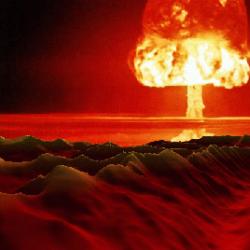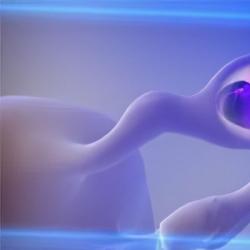What is the valve photoelectric effect. The photoelectric effect is valve. Volt-ampere characteristic of the photoelectric effect
barrier layer photoelectric effect
The physics of the photoelectric effect of the barrier (blocking) layer (valve photoelectric effect) is considered. The mechanism of occurrence of electromotive forces under the action of light is analyzed on the example of cuprous oxide.
In the photoconductivity section, it was shown that, under the action of absorbed light, electrons can pass from a filled band to a free band, thus creating photoconductivity. In this case, only additional conductivity appears in the semiconductor, but no intrinsic electromotive forces are formed. However, another phenomenon is also known - the appearance of electromotive forces as a result of illumination of a semiconductor. For example, if a semiconductor is subjected to uneven illumination so that some parts of the sample are illuminated much stronger, while others are much weaker, it is possible in some cases to detect a certain potential difference between light and dark areas. This phenomenon is explained by the fact that at the moment of illumination, electrons begin to diffuse from the illuminated areas to the dark ones in a greater number than in the opposite direction. Such preferential diffusion leads to the fact that dark areas in the case of an electronic conduction mechanism are gradually charged negatively, and light areas are positively charged. As a result, a gradually increasing electric field is formed inside the semiconductor, which, in the end, will establish an equilibrium state, characterized by the fact that the electron flows in both directions are equal. When equilibrium occurs, there will be a certain potential difference between the light and dark parts of the semiconductor, sometimes reaching up to 0.2 V.
However, the most interesting manifestation of the effect of light on a semiconductor is the existence of the so-called barrier layer photoelectric effect.
Oxidize a copper plate, forming a layer of cuprous oxide Cu 2 0, which is a classical semiconductor. Apply a very thin layer of metal, such as silver, to the surface of cuprous oxide. It is known that very thin metallic layers are translucent. Then we will make a simple electrical circuit. To a translucent silver electrode we will bring a wire from one clamp of the galvanometer, the second clamp of which we will connect to a copper plate. This circuit is characterized by the fact that there is no current source in it. If a stream of advice is directed to the upper translucent silver electrode, then the galvanometer needle will go far to the right of its zero position, since current will flow in the circuit. This phenomenon is due to the existence of a barrier layer in the metal-semiconductor system.
In the case under consideration, under the action of light, electrons pass from cuprous oxide through the barrier layer to copper. Consequently, the copper plate is charged negatively, and the translucent electrode is positively charged. Thus, irradiation of copper oxide surface with light causes an electric current to appear in the circuit. A similar phenomenon is observed in other semiconductors. This effect is especially pronounced in systems containing semiconductors such as thallium sulfide, silver sulfide, selenium, germanium, silicon, and cadmium sulfide.
The phenomenon of the occurrence of an electromotive force or an electric current under the action of light in systems consisting of electronic and "hole" semiconductors, a barrier layer and metal electrodes is called the barrier layer photoelectric effect or valve photoelectric effect.
What is the nature of the valve photoelectric effect? The mechanism of this phenomenon consists of several stages. The first stage is that the absorbed light simultaneously releases electrons and holes in the semiconductor, forming so-called "electron-hole" pairs. The release of pairs is reduced to the fact that electrons from the filled zone are transferred to the free zone, thus becoming conduction electrons, while holes remain in the filled zone and also get the opportunity to participate in electrical conduction.
If light were absorbed in any one semiconductor not in contact with another semiconductor, then the pairs that arose under the action of light would only increase the conductivity of the given semiconductor, and that would be the end of the whole thing. Quite different takes place in the system we are considering, which consists of semiconductors with electronic conductivity (denoted by the letter n) and hole conductivity (denoted by the letter p). A barrier layer is enclosed between the two semiconductors. The contact of p and n semiconductors leads to the formation of a contact electric field between them. And if the work function of the "hole" semiconductor is greater than the work function of the electronic one, which is necessary for two semiconductors of the same chemical composition, then this contact electric field is directed from the electronic semiconductor to the "hole" one. What will happen in this case with couples? Obviously, minority current carriers "liberated" by light, i.e., electrons in a hole semiconductor or holes in an electronic one, under the action of this field, will pass through the blocking layer from one semiconductor to another. As the minority current carriers pass from one semiconductor to another, their accumulation in one part of the system under consideration will increase, while in the other part the majority current carriers will accumulate. Thus, the pairs formed by light will begin to separate: electrons will concentrate in the electronic semiconductor, and holes - in the hole one. This accumulation cannot continue indefinitely because, in parallel with the increase in the concentration of holes in a "hole" semiconductor and electrons in an electronic one, the electric field created by them increases, which prevents the transition of minority carriers from one semiconductor through the barrier layer to another semiconductor. At the same time, as this field increases, the reverse flux of minority photocarriers also increases. In the end, dynamic equilibrium will come when the number of minority carriers moving per unit of time through the blocking layer becomes equal to the number of the same carriers moving in the same time period in the opposite direction. At this moment, some final potential difference will be established between the upper and lower electrodes, which in essence will represent the photoelectromotive force.
Speaking about the establishment of such a dynamic equilibrium, it should be borne in mind that the number of minority photocarriers N moving per unit time from the illuminated semiconductor through the blocking layer to another semiconductor depends on the intensity of the light flux. With an increase in the intensity of the light flux, the numerical value of N increases. First, this increase follows a linear law, and then the increase in N begins to lag more and more behind the increase in the intensity of the light flux until complete saturation occurs. In accordance with the change in N, depending on the change in the luminous flux, the magnitude of the photoelectromotive force also changes, which, ultimately, is of the main interest in this phenomenon.
Such, in the most general terms, is the mechanism for the emergence of a photoelectromotive force in a system consisting of p and n semiconductors and a barrier layer enclosed between them.
The valve photoelectric effect is especially active in semiconductor systems with a large diffusion length of "minority" current carriers and, accordingly, a long lifetime.
From consideration of the mechanism of occurrence of the valve photoelectromotive force, it can be seen that the electrode in direct contact with the electronic semiconductor is always charged negatively, while the electrode in direct contact with the hole semiconductor is positively charged. Therefore, for different types of valve photocells, the upper translucent electrode can acquire both a positive charge and a negative one.
The discovery of the photoelectric effect of the barrier layer expanded the possibilities of practical use of semiconductors and formed the basis for the device of valve photocells - devices that directly and directly convert radiant energy into electrical energy.
M.S. Sominsky. Semiconductors. (Photoelectric effect of the barrier layer).
Lab #58
Goal of the work:
1. Familiarize yourself with the phenomenon of the valve photoelectric effect.
2. Investigate the characteristics of valve photocell.
Theoretical Introduction
The valve photoelectric effect consists in the occurrence of photo-EMF in the rectifying contact when it is illuminated. The valve photoelectric effect observed in district transition.
In the region of the semiconductor interface R-type and n-type, the so-called barrier layer is formed, depleted of the main charge carriers - electrons from the side of the electronic semiconductor and holes - from the side of the hole semiconductor. Ions of donor and acceptor impurities of this layer, respectively, create a positive space charge in n- area and negative - in R- areas. Between R- And n- areas there is a contact potential difference that prevents the movement of the main carriers.
When illuminated district transition, for example, from R-regions with light, the quantum energy of which is sufficient for the formation of an electron-hole pair, near the boundary district transition, so-called photoelectrons and photoholes are formed (internal photoelectric effect). Formed in R-carrier regions participate in thermal motion and move in various directions, including towards district transition. However, due to the presence of a contact potential difference, the holes will not pass into n-region. Electrons, on the other hand, will be dragged by the field into n-area (Figure 1).
If the photocell circuit is open ( R n = ∞, idle mode), then the accumulation of photoelectrons in n-regions and photoholes in R-region leads to the appearance of an additional potential difference between the electrodes of the photocell. This potential difference is called photo-EMF ( U f xx). The accumulation of non-equilibrium carriers in the corresponding regions cannot continue indefinitely, since at the same time the height of the potential barrier decreases by the amount of the photo-emf that has arisen. A decrease in the height of the potential barrier or a decrease in the resulting electric field strength worsens the "separating" properties pn transition.
If you short-circuit the electrodes of the photocell ( R n = 0), then the charge carriers formed by light will circulate in the photocell circuit, creating a short circuit photocurrent I f kz. The value of the photo-emf of idling U f xx and short circuit photocurrent strength I f kz are determined by the concentration of charge carriers formed by light, which, in turn, depends on the illumination of the photocell E.
 Photocurrent dependencies I f kz and photo-EMF U f xx from the illumination of the photocell E(or from the light flux Ф = E∙S, Where S- the area of the receiving surface of the photocell) are called the light characteristics of the photocell (Figure 2).
Photocurrent dependencies I f kz and photo-EMF U f xx from the illumination of the photocell E(or from the light flux Ф = E∙S, Where S- the area of the receiving surface of the photocell) are called the light characteristics of the photocell (Figure 2).
From what has been said above, it follows that the valve photocell allows for the direct conversion of radiant energy into electrical energy. In order to use the received electrical energy, it is necessary to include a load resistance in the photocell circuit R n. Useful power will be released on this resistance
P = I∙U = I 2 ∙R n,(1)
Where I- current strength in the photocell circuit ( I< I ф кз ), A,
U- voltage at the contacts of the photocell ( U< U ф хх ), IN.
Current strength I, voltage U, and hence the power P at constant illumination is determined by the value of the load resistance R n. By changing the resistance R n from ∞ to 0, you can get the dependence U(I), which is called the load characteristic of the valve photocell (Figure 3).
 The decrease in voltage at the terminals of the photocell with an increase in the load current is due to the loss of voltage on the internal resistance of the photocell. In short circuit mode, when R n is equal to zero, all the voltage developed by the photocell U f xx drops on the internal resistance, and the voltage at the output of the photocell is also zero.
The decrease in voltage at the terminals of the photocell with an increase in the load current is due to the loss of voltage on the internal resistance of the photocell. In short circuit mode, when R n is equal to zero, all the voltage developed by the photocell U f xx drops on the internal resistance, and the voltage at the output of the photocell is also zero.
In practice, the load resistance is selected in such a way that the power allocated to it is maximum. At the same time, the maximum (for a given illumination) value is also reached by the efficiency of the valve photocell, which is determined by the ratio
η = P∙Ψ / Ф = P∙Ψ / (E∙S),(2)
where Ψ is the so-called light output, which for a wavelength λ \u003d 535 nm is equal to 628 lm / W.
Valve photocells are made from selenium, silicon, germanium, silver sulfide and other semiconductor materials. They are widely used in automation, measuring technology, calculating mechanisms and other devices. For example, selenium photocells, whose spectral sensitivity is close to the spectral sensitivity of the human eye, are used in photometric devices (exposure meters, photometers, etc.).
Silicon photocells are widely used as converters of solar energy into electrical energy. The efficiency of silicon photocells is ≈ 12%. A large number of solar cells connected to each other form a solar battery. The voltage of solar panels reaches tens of volts, and the power - tens of kilowatts. Solar batteries serve as the main source of energy for spacecraft.
 |
Installation description
 A silicon valve photocell is a silicon plate cut from a single crystal n- type, on the surface of which, by heating at a temperature approximately equal to 1200 0 C in vapors BCl 3 a thin silicon film is formed R-type. The photocell is fixed on an optical bench along which the light source moves. By changing the distance between the surface of the photocell and the light source, it is possible to change the illumination of the photocell. Light value E(l) corresponding to the distance l between the illuminator and the photocell, is determined by the calibration curve (Figure 5).
A silicon valve photocell is a silicon plate cut from a single crystal n- type, on the surface of which, by heating at a temperature approximately equal to 1200 0 C in vapors BCl 3 a thin silicon film is formed R-type. The photocell is fixed on an optical bench along which the light source moves. By changing the distance between the surface of the photocell and the light source, it is possible to change the illumination of the photocell. Light value E(l) corresponding to the distance l between the illuminator and the photocell, is determined by the calibration curve (Figure 5).
Gate photoelectric effect
Animation
Description
The valve (barrier) photoelectric effect occurs in inhomogeneous (by chemical composition or inhomogeneously doped with impurities) semiconductors, as well as at the semiconductor-metal contact. In the region of inhomogeneity, there is an internal electric field, which accelerates minor nonequilibrium carriers generated by radiation. As a result, photocarriers of different signs are spatially separated. Gate photovoltage can be produced by light that generates minority carriers. Especially important is the valve photovoltage in the p-n-junction and heterojunction, i.e. in contact of two semiconductors with different chemical composition.
On fig. 1 schematically shows the separation of pairs that occurs when a p-n junction is illuminated.
Separation of electron-hole pairs excited by light at the p-n junction

Rice. 1
The contribution to the current is made both by carriers generated directly in the region of the p-n junction, and excited in the near-transition regions and reaching the region of a strong field by diffusion. As a result of pair separation, a corrected flow of electrons into the n-region and holes into the p-region is formed. With an open circuit, an EMF is created in the throughput (forward) direction of the p-n junction, compensating for this current.
Depending on the doping of both sides of the heterojunction, it is possible to create a p-n - heterojunction (anisotype) and an n-n - heterojunction or p-p - heterojunction (isotype).
The combination of various heterojunctions and monojunctions forms certain heterostructures.
The most widely used single-crystal heterojunctions between semiconductor materials based on arsenides, phosphides and antimonides Ga and Al, due to the closeness of their covalent radii.
Photocells on p-n - junctions or heterojunctions have a low inertia and provide direct conversion of light energy into electrical energy.
Timing
Initiation time (log to -3 to -1);
Lifetime (log tc from -1 to 7);
Degradation time (log td -3 to -1);
Optimal development time (log tk 0 to 6).
Diagram:

Technical realizations of the effect
A standard photodiode (preferably with a large receiving area, such as F24K or similar) is connected to the input of the oscilloscope and illuminated by light from a fluorescent lamp. We observe an EMF oscillating with a double mains frequency (that is, 100 Hz).
Applying an effect
The valve (barrier) photoelectric effect is used in photovoltaic and solar cells, as well as in devices for detecting inhomogeneities in semiconductor materials and photodetectors for measuring light fluxes.
A solar battery (photoelectric generator) is a device that directly converts the energy of light radiation into electrical energy. The electric current in the solar battery arises as a result of the processes occurring in photocells when solar radiation hits them. The most efficient solar panels are based on the excitation of EMF at the boundary between the conductor and a light-sensitive semiconductor (for example, silicon) or between dissimilar conductors. The power of the solar battery reaches 100 kW, the efficiency is 10–20%.
The gate photoelectric effect is the emergence of an electromotive force during the absorption of radiation quanta of the optical range in a system containing a contact of two impurity semiconductors with different types of conductivity or in a semiconductor-metal system.
On fig. 3 shows the energy diagram of the p-n junction without illumination (E c , E v and E F are the energies of the bottom of the conduction band, the top of the valence band and the Fermi level, respectively, E g is the band gap).
| Fig.3. Energy diagram p-n junction without lighting. |
 Fig.4. Energy diagram of the p-n junction when illuminated. Fig.4. Energy diagram of the p-n junction when illuminated. |
When such a system is illuminated by photons with energy hn > E g , the absorbed light transfers electrons from the valence band to the conduction band. In this case, holes are formed in the valence band; there is a generation of electron-hole pairs (Fig. 4). The behavior of nonequilibrium carriers depends on the region of the system where the radiation is absorbed. For each region, the behavior of minority carriers is important, since it is their density that can vary over a wide range under illumination. The density of the majority carriers on both sides of the semiconductor interface remains virtually unchanged. If radiation is absorbed in the p-region, then electrons located at a distance from the p-n junction less than the diffusion path length will be able to reach it and, under the action of a contact electric field, will move to the n-region.
Similarly, if radiation is absorbed in the n-region, then only holes are ejected through the p-n junction into the p-region.
If the pairs are generated in the region of the space charge (p-n transition), then the field "separates" the charge carriers in such a way that they end up in the region where they are the main ones.
So, the pairs formed by the light will be separated. In this case, electrons are concentrated in the n-semiconductor, and holes - in the p-semiconductor, i.e. The p-n junction plays the role of a "drain" for minority charge carriers.
This accumulation of charges cannot continue indefinitely: in parallel with the increase in the concentration of holes in the p-semiconductor and electrons in the n-semiconductor, the electric field created by them increases, which prevents further transition of minority carriers through the blocking layer.
As this field increases, the reverse flow of minority carriers also increases. In the end, a dynamic equilibrium will come in which the number of minority carriers moving per unit of time through the blocking layer will be equal to the number of the same carriers moving in the opposite direction in the same time interval.
PHOTOEFFECT VALVE
photoelectric effect in the barrier layer, - the occurrence under the influence of electromagnetic radiation electromotive force(photovoltage) in a system consisting of two contacting different PPs or of PP and metal. The largest practical of interest is F. v. in p-i-transition and heterojunction. F. in. used in photovoltaics. generators, in PP photodiodes, phototransistors etc.
. 2004 .
See what "VENT PHOTOEFECT" is in other dictionaries:
Quantum mechanics ... Wikipedia
The redistribution of electrons in energy. states in solid and liquid PP and dielectrics, occurring under the action of an electromagnet. radiation. F. in. is detected, as a rule, by a change in the concentration of current carriers in the medium, i.e., by the appearance of ... Big encyclopedic polytechnic dictionary
valve photoelectric effect- Internal photoelectric effect, in which emf occurs. [Collection of recommended terms. Issue 79. Physical optics. USSR Academy of Sciences. Committee of Scientific and Technical Terminology. 1970] Topics physical optics Generalizing terms transformation ... ... Technical Translator's Handbook
PHOTO EFFECT, a group of phenomena associated with the release of electrons of a solid body from intra-atomic bonding under the influence of electromagnetic radiation. There are: 1) external photoelectric effect, or photoelectron emission, emission of electrons from the surface ... ... Modern Encyclopedia
A phenomenon associated with the release of electrons from a solid (or liquid) under the influence of electromagnetic radiation. There are: ..1) external photoelectric effect - the emission of electrons under the action of light (photoelectronic emission),? radiation, etc.; ..2) ... ... Big Encyclopedic Dictionary
PHOTO EFFECT- (1) valve occurrence of an electromotive force (photoEMF) between two dissimilar semiconductors or between a semiconductor and a metal under the influence of electromagnetic radiation; (2) F. external (photoelectronic emission) emission of electrons from ... Great Polytechnic Encyclopedia
A; m. Phys. Changing the properties of a substance under the influence of light energy; photoelectric effect. * * * The photoelectric effect is a phenomenon associated with the release of electrons from a solid (or liquid) under the influence of electromagnetic radiation. Distinguish: ... ... encyclopedic Dictionary
valve photoelectric effect
barrier layer photoelectric effect- užtvarinis fotoefektas statusas T sritis fizika atitikmenys: engl. barrier layer photoeffect; barrier layer photoelectric effect; photovoltaic effect vok. Sperrschichtphotoeffekt, m rus. valve photoelectric effect, m; photovoltaic effect, m;… … Fizikos terminų žodynas
The phenomenon associated with the release of electrons TV. body (or liquid) under the influence of email. magn. radiation. Distinguish: external. F. emission of electrons under the influence of light (photoelectronic emission), radiation, etc .; internal F. increase ... ... Natural science. encyclopedic Dictionary






